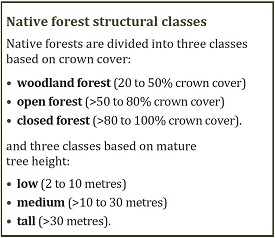Information for this profile is drawn from Australia's State of the Forests Report 2018.
Acacia forest is Australia’s second most common forest type after Eucalypt forest, with 10.8 million hectares or 8.2% of Australia's total native forest area. Almost 1,000 species of acacia occur in Australia, making it the nation’s largest genus of flowering plants.
Acacias are remarkably varied in appearance and habit, ranging from low-spreading shrubs to trees more than 30 metres tall. Commonly referred to as wattles, acacias are well known for their mass of bright yellow flowers. Golden wattle (Acacia pycnantha) is the national floral emblem and appears on the coat of arms of Australia.
Acacias have a range of foliage types. Some species have true leaves that are divided into leaflets called pinnae. Others have leaf-like structures called phyllodes, which are flattened leaf stalks. The colour of the foliage varies from light or dark green to silver-grey.
Distribution and ownership
Acacia forests are located in all Australian states and the Northern Territory (Map 1). They grow mainly in arid and semi-arid regions. A total of 5.1 million hectares (47%) of the Acacia forest type is in Queensland and 3.2 million hectares (30%) are in Western Australia.
Open a high-resolution version of Map 1 that can be saved as a PNG file
Mulga (A. aneura and related species) is widespread across central Australia. Brigalow (A. harpophylla) is widespread across Queensland and northern New South Wales, forming dense forests on flat or undulating country with clay soils. Both mulga and brigalow form forest and non-forest communities.
Some species of acacia are also present in wetter areas. For example, in Tasmania, blackwood (A. melanoxylon) dominates stands of swamp forest on poorly drained sites. Silver wattle (A. dealbata) is common on tablelands and foothills from northern New South Wales to western Victoria and Tasmania.
A total of 7.0 million hectares (65%) of Acacia forest is on leasehold land and 2.1 million hectares (20%) are on private land (Table 1).

Download Table 1 data as an Excel workbook
Forest structure

A total of 8.5 million hectares (79%) of Acacia forest is woodland forest and 8.5 million hectares (79%) are low forest (Figure 1). These characteristics are typical of Acacia forest in the arid and semi-arid regions.
Download Figure 1 data as an Excel workbook
Importance and uses
Acacias help to protect the landscape by stabilising soils and preventing erosion. They also enrich the soil by fixing nitrogen, an essential nutrient for plant growth. This process depends on symbiotic bacteria called rhizobia that live in the plant’s root system. Acacias are one of the first plants to regenerate after a disturbance such as a bushfire.
Acacia wood has traditionally been used by Indigenous Australians for making spears, clubs and hunting boomerangs. Early in the colonial period the wood was widely used for cabinet-making and everyday furniture, but today its use is limited to fine furniture.
Acacias are among the most attractive flowering plants in Australia. Common flower colours are bright and golden yellows, but the flowers of some species are almost white to orange-yellow. Acacia flowers and foliage are often used in floral arrangements.
Acacias are used as fodder plants and feed for sheep, especially in drought-affected areas when alternative feed sources are scarce.
Bibliography
ABARES 2019, Forests of Australia (2018), Australian Bureau of Agricultural and Resource Economics and Sciences, Canberra.
Boland, D, Brooker, M, Chippendale, G, Hall, N, Hyland, B, Johnston, R, Kleinig, D, McDonald, M & Turner, J 2006, Forest trees of Australia, 5th edn, CSIRO Publishing, Melbourne.
Carnahan, JA 1990, Atlas of Australian resources, vol. 6, Vegetation, Australian Government Publishing Service, Canberra.
Montreal Process Implementation Group for Australia & National Forest Inventory Steering Committee 2018, Australia's State of the Forests Report 2018, Australian Bureau of Agricultural and Resource Economics and Sciences, Canberra.

